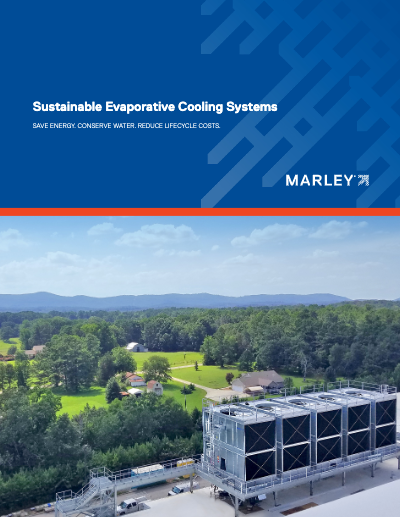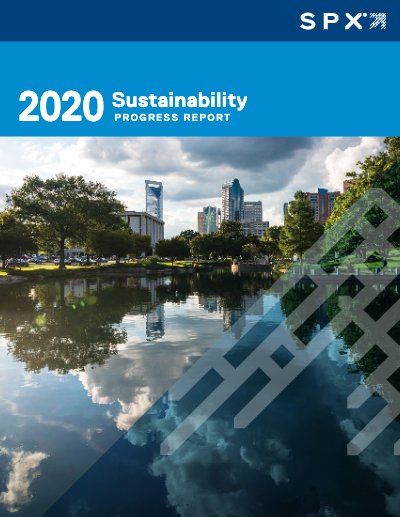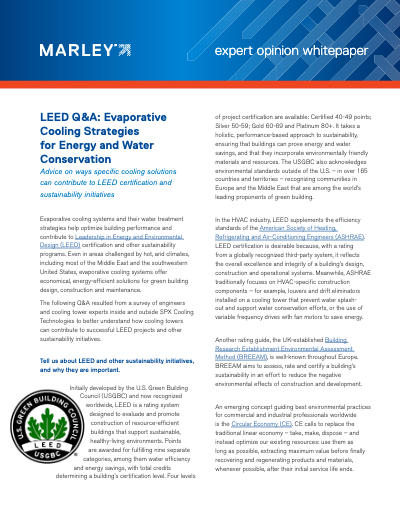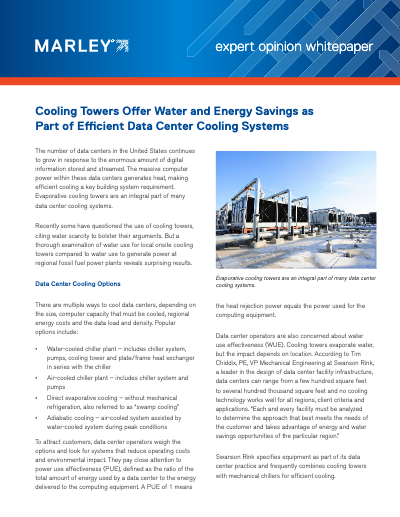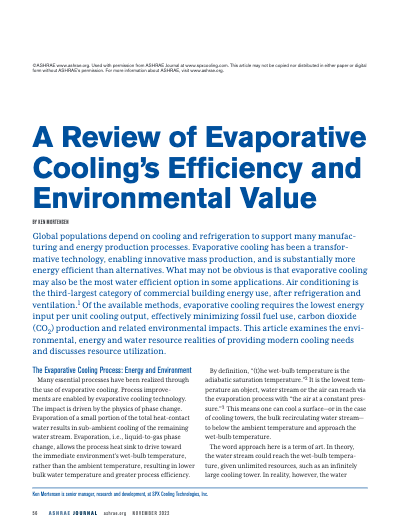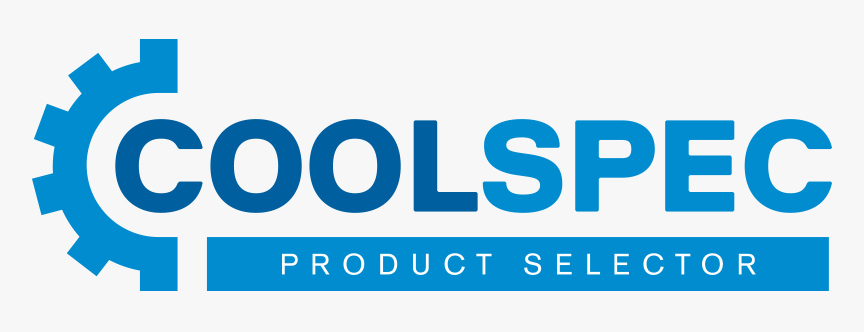Cooling Towers for Sustainable Building Projects
Naturally Efficient, Naturally Cool. Naturally Marley.
Inspired by processes born in nature, evaporative cooling towers are the ideal heat rejection solution for sustainable construction projects due to their potential for energy savings and low environmental impact. Effectively managing cooling tower water to minimize make-up and blowdown volumes offers the opportunity to gain water resource credits as well. Even in areas challenged by hot, arid climates, including most of the Middle East and the southwestern United States, evaporative cooling systems offer cost-effective, energy-efficient solutions for sustainable building design, construction, operation, and maintenance.
Sustainable building standards have evolved from being the innovative exception to becoming the norm for many communities. Today, building designers, engineers and managers expect manufacturers of HVAC systems to dedicate R&D resources to commercialize environmentally responsible cooling systems that offer exceptional performance and value while meeting global ASHRAE, LEED and other sustainability standards.

ASHRAE 90.1 Minimum Energy Efficiency for Open Cooling Towers
Values of 40.2 gallons per minute per horsepower (12.24 m3/h/kW) for axial fan open cooling towers, and 20 gallons per minute per horsepower (6.09 m3/h/kW) for centrifugal fan open cooling towers are required at standard conditions of 95°F hot water, 85°F cold water, 75°F wet bulb (35/29.5/23.9°C). All U.S. states have adopted these or stricter standards for comfort cooling applications. Standard Marley cooling tower models are available that range from 30 to 400 gpm/hp.
INTERESTED IN SUSTAINABLE BUILDING PROJECTS?
Connect with one of our sustainable building experts by completing the form below!
FREQUENTLY ASKED QUESTIONS
The following Q&A resulted from a survey of engineers and cooling tower experts inside and outside SPX Cooling Tech to better understand how cooling towers can successfully contribute to sustainable construction initiatives.
What are the most recognized building sustainability certification programs and why are they important?
Developed by the U.S. Green Building Council (USGBC) and recognized worldwide, Leadership in Energy and Environmental Design (LEED) is a rating system designed to evaluate and promote construction of resource-efficient buildings that support sustainable, healthy-living environments. Points are awarded for fulfilling nine separate categories, among them water efficiency and energy savings, with total credits determining one of four building certification levels. The USGBC also acknowledges environmental standards outside of the U.S. – in over 165 countries and territories – recognizing communities in Europe and the Middle East that are among the world’s leading proponents of green building. According to the USGBC website, “people know that if they are in a LEED-certified building they are using less energy and water, avoiding waste, saving on maintenance costs, improving indoor air quality, offering comfort to their occupants, and creating less environmental burden on their community. They also know that they are in a building that enhances health and wellness. Now green building has grown into a trillion-dollar industry, and LEED has become the most widely used green building program in the world.”
In the HVAC industry, LEED supplements the efficiency standards of the American Society of Heating, Refrigerating and Air-Conditioning Engineers (ASHRAE). LEED certification is desirable because, with a rating from a globally recognized third-party system, it reflects the overall excellence and integrity of a building’s design, construction and operational systems. Meanwhile, ASHRAE traditionally focuses on HVAC-specific construction components – for example, louvers and drift eliminators installed on a cooling tower that prevent water splash-out and support water conservation efforts, or the use of variable frequency drives with fan motors to save energy.
The WELL Building Standard™ (WELL) is a performance-based system for measuring, certifying, and monitoring features of the built environment that impact the health and wellness of the people who live, work, and learn in the buildings. WELL focuses on seven categories of building performance: air, water, nourishment, light, fitness, comfort, and mind. The WELL Building Standard is grounded in evidence-based research that demonstrates the connection between the buildings where people spend more than 90 percent of their time and those buildings’ health and wellness impacts on those who use them. The WELL Building Standard is administered by the International WELL Building Institute™ and third-party certified by Green Business Certification Inc. (GBCI).
Another rating guide, the UK-established Building Research Establishment Environmental Assessment Method (BREEAM), is well-known throughout Europe. BREEAM aims to assess, rate and certify a building’s sustainability in an effort to reduce the negative environmental effects of construction and development.
An emerging concept guiding best environmental practices for commercial and industrial professionals worldwide is the Circular Economy (CE). CE calls to replace the traditional linear economy – take, make, dispose – and instead optimize our existing resources: use them as long as possible, extracting maximum value before finally recovering and regenerating products and materials, whenever possible, after their initial service life ends.
For example, Marley® stainless steel cooling towers can comprise up to 100 percent recycled material, and some galvanized steel towers comprise at least 23 percent recycled material. When decommissioned, the steel can again be recycled for other uses, a cycle that supports the circular economy philosophy.
What advance planning is required of building design teams who wish to incorporate evaporative cooling in building sustainability projects?
Because most buildings constructed today employ some method for cooling indoor air, engineers and architects may seek the most efficient, environmentally sustainable method possible. Sustainability rating systems, reward environmentally sustainable practices that conserve energy, material, and water resources. Here are examples using the LEED system:
An evaporative cooling tower system capable of achieving these goals has the potential to earn points toward the LEED energy optimization credit, including up to 20 in existing buildings and up to 18 in new buildings. A building design team aiming to optimize energy performance can get about halfway to certification by implementing HVAC-related strategies and equipment choices that contribute to increased efficiency. A building becomes LEED certified at a minimum of 40 points.
First, to earn points toward certification, buildings must meet a few prerequisites. For new buildings, design teams can demonstrate the cooling tower’s contribution to indoor water reduction with make-up water meters, conductivity controllers and overflow alarms, and drift eliminators. New buildings can also pre-qualify for certification if owners commit to water metering and fundamental commissioning and verification.
Fundamental commissioning and verification include implementation of a “facilities requirements and operations plan,” which may address equipment run-time schedules and HVAC set points that optimize energy use.
Cooling towers evaporate an HVAC system’s recirculated water to remove heat. Only small amounts of water are required to be recirculated through the system. Water in the evaporative cooling tower mixes with air flow – typically produced by a fan (often using a variable frequency drive to save energy); evaporation of the hot water results, creating a cooling action.
Cooling tower operation can be optimized in several ways to directly contribute to LEED certification:
- Operating a cooling tower under variable flow conditions at off-peak times can achieve greater efficiency by reducing flow rate and fan energy, as long as proper water distribution is achieved. Examples:
- Running half the fans at full speed for 50 percent cooling at half the energy usage.
- Running all the fans at half speed for 50 percent cooling at one-eighth the energy usage.
- Monitoring water consumption to identify ways to minimize use. As mentioned earlier, water metering can potentially help an existing building earn up to two points and a new building up to one point. The Marley Water Usage Calculator helps building planners determine how much water they can save using evaporative cooling in their specific applications.
- Incorporating water quality management, contaminant control, and cycles of concentration as part of system water conservation. Achieving water conservation has the potential of earning an existing building up to three points and a new building up to two points.
Maximizing “cycles of concentration” is a recommended water conservation practice. Cycles of concentration is defined as the resulting ratio of concentrated dissolved solids in the circulating “blowdown” water compared to that in the fresh make-up water. Increasing cycles of concentration can greatly reduce blowdown and make-up water simultaneously, creating a water chemistry equilibrium that conserves water and removes minerals that dissolved during the evaporative cooling process.
At the same time, the quantity of dissolved solids must be carefully controlled. Implementing an effective water treatment program with tools to monitor water quality empower cooling tower operators to proactively address issues related to microorganisms, corrosion, scale and water conservation.
How does relative humidity impact the evaporative cooling process, and why is that important in arid parts of the world?
Relative humidity measures the difference between moisture actually in the air and the amount of moisture the air could hold. That is the difference between wet bulb temperature, or the amount of moisture in the air, and dry bulb temperature, the outdoor temperature. At 100 percent relative humidity, wet and dry bulb temperatures are the same. In evaporative cooling systems, heat is transferred based on wet bulb, while dry systems rely on dry bulb. Evaporative systems are capable of producing cold-water temperatures near wet bulb levels that often fall below outdoor dry bulb temperatures, which result in energy savings in arid areas. Dry systems, on the other hand, have to work against high dry bulb temperatures year-round in areas like the Middle East.
In arid climates with limited or no water resources, hybrid cooling towers may help limit water consumption. The hybrid combination of wet and dry components maximizes cooling efficiency under high heat load conditions while achieving water savings at reduced load. Innovative hybrid products using both wet and dry technologies – like the Marley NCWD Cooling Tower – first cool water through a dry section at the top of the tower, offering additional water savings and another way to potentially earn points toward the innovation credit. The NCWD tower can reduce annual water consumption by up to 20 percent, depending on climate and the facility’s heat load profile
Are there benefits of using water-cooled versus air-cooled cooling systems?
What cooling tower controls or components can building operators use to achieve additional energy savings?
The use of variable frequency drives (VFDs) with fans is recommended. With two-speed fan motors, any time you need greater than 50 percent cooling capacity, fan power needs to be increased to 100 percent to reach it. VFD systems are designed to combine absolute temperature control with ideal energy management. The cooling tower user selects a cold-water temperature and the drive system will vary the fan speed to maintain that temperature. Using VFDs can significantly reduce annual energy consumption in most climates, making them essential for projects focused on energy efficiency and sustainability.
When used with a VFD, the use of a permanent magnet motor may be as energy efficient as a gear drive, but the initial cost can be significantly higher. In addition to these two factors, building managers should consider ease of maintenance, reliability and service life, balanced against installation costs, operational complexity and environmental impact.
How does the size of a cooling tower affect energy savings?
Physically larger cooling towers are more efficient because they typically have more heat transfer media (fill) volume, allowing them to use less air flow and lower fan power for increased energy savings. Numerous combinations of physical tower size and fan power can meet certain temperature requirements for a specific water flow. Because maximizing power savings generally requires using a larger, and potentially more costly cooling tower, system designers should consult with cooling tower manufacturers for help weighing the costs compared with power consumption benefits to find a solution that best meets their requirements.
LEED sets the ASHRAE 90.1 efficiency as the threshold for compliance before being considered for LEED credits. Credits are granted based on improvements in overall building energy efficiency that are better than ASHRAE 90.1.
Towers that are selected larger in physical size with energy efficiency in gallons per minute per horsepower above ASHRAE 90.1 can help to acquire LEED credits. The use of variable frequency drives (VFDs) can also enable significant annual energy savings in most climates, which also can help to enable LEED credits.
Our Tower Sizing and Selection software can assist you by providing the ASHRAE efficiency calculation on the output of each selection.
What is ASHRAE 90.1?
How can my cooling tower help with LEED certification and credits?
Because most buildings constructed today employ some method for cooling indoor air, engineers and architects may seek the most efficient, environmentally sustainable method possible. Sustainability rating systems, reward environmentally sustainable practices that conserve energy, material, and water resources. Here are examples using the LEED system:
An evaporative cooling tower system capable of achieving these goals has the potential to earn points toward the LEED energy optimization credit, including up to 20 in existing buildings and up to 18 in new buildings. A building design team aiming to optimize energy performance can get about halfway to certification by implementing HVAC-related strategies and equipment choices that contribute to increased efficiency. A building becomes LEED certified at a minimum of 40 points.
First, to earn points toward certification, buildings must meet a few prerequisites. For new buildings, design teams can demonstrate the cooling tower’s contribution to indoor water reduction with make-up water meters, conductivity controllers and overflow alarms, and drift eliminators. New buildings can also pre-qualify for certification if owners commit to water metering and fundamental commissioning and verification.
Fundamental commissioning and verification include implementation of a “facilities requirements and operations plan,” which may address equipment run-time schedules and HVAC set points that optimize energy use.
Cooling towers evaporate an HVAC system’s recirculated water to remove heat. Only small amounts of water are required to be recirculated through the system. Water in the evaporative cooling tower mixes with air flow – typically produced by a fan (often using a variable frequency drive to save energy); evaporation of the hot water results, creating a cooling action.
Cooling tower operation can be optimized in several ways to directly contribute to LEED certification:
- Operating a cooling tower under variable flow conditions at off-peak times can achieve greater efficiency by reducing flow rate and fan energy, as long as proper water distribution is achieved. Examples:
- Running half the fans at full speed for 50 percent cooling at half the energy usage.
- Running all the fans at half speed for 50 percent cooling at one-eighth the energy usage.
- Monitoring water consumption to identify ways to minimize use. As mentioned earlier, water metering can potentially help an existing building earn up to two points and a new building up to one point. The Marley Water Usage Calculator helps building planners determine how much water they can save using evaporative cooling in their specific applications.
- Incorporating water quality management, contaminant control, and cycles of concentration as part of system water conservation. Achieving water conservation has the potential of earning an existing building up to three points and a new building up to two points.
Maximizing “cycles of concentration” is a recommended water conservation practice. Cycles of concentration is defined as the resulting ratio of concentrated dissolved solids in the circulating “blowdown” water compared to that in the fresh make-up water. Increasing cycles of concentration can greatly reduce blowdown and make-up water simultaneously, creating a water chemistry equilibrium that conserves water and removes minerals that dissolved during the evaporative cooling process.
At the same time, the quantity of dissolved solids must be carefully controlled. Implementing an effective water treatment program with tools to monitor water quality empower cooling tower operators to proactively address issues related to microorganisms, corrosion, scale and water conservation.
Cooling tower efficiency is largely driven by operation and maintenance standards, but climate also plays a role. When relative humidity is low, as it is in hot and dry regions like the Middle East, the more beneficial evaporative cooling is for building owners.
Relative humidity measures the difference between moisture actually in the air and the amount of moisture the air could hold. That is the difference between wet bulb temperature, or the amount of moisture in the air, and dry bulb temperature, the outdoor temperature. At 100 percent relative humidity, wet and dry bulb temperatures are the same. In evaporative cooling systems, heat is transferred based on wet bulb, while dry systems rely on dry bulb. Evaporative systems are capable of producing cold-water temperatures near wet bulb levels that often fall below outdoor dry bulb temperatures, which result in energy savings in arid areas. Dry systems, on the other hand, have to work against high dry bulb temperatures year-round in areas like the Middle East.
In arid climates with limited or no water resources, hybrid cooling towers may help limit water consumption. The hybrid combination of wet and dry components maximizes cooling efficiency under high heat load conditions while achieving water savings at reduced load. Innovative hybrid products using both wet and dry technologies – like the Marley NCWD Cooling Tower – first cool water through a dry section at the top of the tower, offering additional water savings and another way to potentially earn points toward the innovation credit. The NCWD tower can reduce annual water consumption by up to 20 percent, depending on climate and the facility’s heat load profile
Are there benefits of using water-cooled versus air-cooled cooling systems?
Yes, and the simple explanation is that air-cooled HVAC systems requiring higher fan power to reduce temperatures are less energy efficient. Air-cooled equipment uses fans to chill a fluid moving through a coil by blowing air across the coil surface, and electricity powers those fans. Depending on the location’s climate, the energy savings realized from water-cooled systems are significant. According to the Hydronics Industry Alliance, a building can save five to 30 percent or more on HVAC energy consumption when using a water-cooled system compared to air-cooled or variable refrigerant flow (VRF) systems
The use of variable frequency drives (VFDs) with fans is recommended. With two-speed fan motors, any time you need greater than 50 percent cooling capacity, fan power needs to be increased to 100 percent to reach it. VFD systems are designed to combine absolute temperature control with ideal energy management. The cooling tower user selects a cold-water temperature and the drive system will vary the fan speed to maintain that temperature. Using VFDs can significantly reduce annual energy consumption in most climates, making them essential for projects focused on energy efficiency and sustainability.
When used with a VFD, the use of a permanent magnet motor may be as energy efficient as a gear drive, but the initial cost can be significantly higher. In addition to these two factors, building managers should consider ease of maintenance, reliability and service life, balanced against installation costs, operational complexity and environmental impact.
Physically larger cooling towers are more efficient because they typically have more heat transfer media (fill) volume, allowing them to use less air flow and lower fan power for increased energy savings. Numerous combinations of physical tower size and fan power can meet certain temperature requirements for a specific water flow. Because maximizing power savings generally requires using a larger, and potentially more costly cooling tower, system designers should consult with cooling tower manufacturers for help weighing the costs compared with power consumption benefits to find a solution that best meets their requirements.
LEED sets the ASHRAE 90.1 efficiency as the threshold for compliance before being considered for LEED credits. Credits are granted based on improvements in overall building energy efficiency that are better than ASHRAE 90.1.
Towers that are selected larger in physical size with energy efficiency in gallons per minute per horsepower above ASHRAE 90.1 can help to acquire LEED credits. The use of variable frequency drives (VFDs) can also enable significant annual energy savings in most climates, which also can help to enable LEED credits.
Our Tower Sizing and Selection software can assist you by providing the ASHRAE efficiency calculation on the output of each selection.

